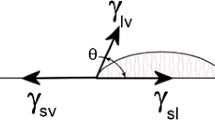Abstract
Carbon Fiber Reinforced Polymers (CFRP) are the basic components for lightweight aircrafts, which are the primary goal of aerospace industry in the close future. The bonding of CFRP panels is based on adhesive technologies but, currently, no NDT technique has been validated for ensuring the quality of the bonds. Chemical surface contamination is the primary cause of weak bonding and potential airframe failures. Operative needs such as portability, rapid reponse, versatility make e-nose technology an interesting solution to develop an ad-hoc tool for surface contamination detection in this scenario.
Access provided by Autonomous University of Puebla. Download conference paper PDF
Similar content being viewed by others
Keywords
- Carbon Fiber Reinforce Polymer
- Carbon Fiber Reinforce Plastic
- Electronic Nose
- Fiber Reinforce Plastic
- Hydraulic Fluid
These keywords were added by machine and not by the authors. This process is experimental and the keywords may be updated as the learning algorithm improves.
Introduction
Lightweight aircrafts represent the primary goal of aerospace industry in the close future. Being able to build up a CFRP (Carbon Fiber Reinforced Plastic) based aircraft will allow for a 15 % weight loss of the airframe that, in turn, will generate considerable savings in aircraft operation (fuel, CO2 emissions) and maintenance [1]. However, CFRP components are not riveted; their bonding is primarily based on adhesive technologies and, currently, no NDT technique has been developed and validated for ensuring the quality of the CFRP adhesive bonds. Low quality bonding would lead to potential cracks with imaginable consequences. In particular, surface contamination is a primary concern being cause of low bonding quality. Hydraulic fluids spills, moisture and release agents residuals represent the most common and dangerous contamination sources.
Operative needs for an NDT tool would require contamination detection to be performed within a few seconds in presence of interferents. Portability is also an important requirement for allowing easy operation in maintenance and repair shops. For this reasons, e-nose technology represent an interesting solution to develop an ad-hoc NDT tool for surface contamination detection in this scenario.
In this work we show the advancements in the screening process of artificial olfaction technologies for the above requirements.
Experimental
The e-nose measuring procedure is illustrated in Table 75.1.
The preliminary screening focused on the possibility to identify Skydrol contaminated CFRP samples from two uncontaminated control groups. A 50 % Skydrol/Water mixture was heated to 70 °C and stirred for 14 days. Oily and water phase were separated and CFRP samples immersed in the “Skydrol” water phase (pH 2). After 4 week, samples were removed and dried with a paper towel. Finally, they were covered with aluminum foil and stored at room temperature under N2 atmosphere with the aim to prevent any loss of contaminants from the CFRP samples.
For measuring purposes, samples were immersed in vials containing water and sonicated in order to extract Skydrol volatiles components to be presented to the polymer electronic nose sampling system. Each sample was measured five times and different samples were measured respecting a 30 min resting interval. A dataset of 15*5 samples was eventually collected to build an appropriate training set. A validation set of 15 samples was also collected 24 hrs later in order to evaluate the generalization and stability characteristics of the proposed approach. Training set LDA analysis shows a significant separation among the contaminated and control samples (see Figs. 75.1 and 75.2).
Results and Discussion
A polymer sensor based commercial solution has been first used for demonstrating the capability to detect SKYDROL500-B (a highly aggressive hydraulic fluid) contamination analyzing a Skydrol/water mixture at 0.6 % v/v [2, 3]. The response of the e-nose was recorded (see Fig. 75.3) and characteristic response features including max response, max climb rate, max descent rate and AUC, were extracted. An LDA analysis demonstrated the discrimination capability of the polymer array correctly separating Skydrol samples from Diesel Oil samples and control (water) samples.
This system was able to correctly classify and recognize 100 % of contaminated samples (Table 75.2) showing the feasibility of the electronic nose approach to the Skydrol surface contamination detection. However compliance with operative requirements is still to be reached. Furthermore, polymer sensors have shown to be prone to significant drift effects. This, in turn, would require frequent recalibrations of any sensor array relying on them. Eventualy, this would complicate the operation of the e-nose. Future analysis will be actually performed with an hybrid e-nose architecture that will allow to test the use of more stable electrochemical, Metal Oxide and IMS technology based sensor array. The use of an integrated IR surface heater has also been devised to increase the volatile uptake by the e-nose sampling system.
Conclusions
In this work, preliminary steps for the screening process of artificial olfaction technologies for the CFRP surface chemical contamination are reported. A polymer sensor based commercial e-nose platform was successfully employed in the discrimination and detection of hydraulic fluid contamination over CFRP surfaces. However compliance with operative requirements is still to be reached.
References
Marcus S et al (2011) Extended Non-Destructive Testing of Composite Bonds. SAE 2011 AeroTech Congress. doi:10.4271/2011-01-2514
Gendard A et al (2010) 2nd international symposium on NDT in aerospace, Hamburg, Germany, 22–24 Nov 2011
Paul S et al (2010) Chemical Contamination Sensor for Phosphate Ester Hydraulic Fluids. Int J Aerospace Eng Vol. 2010, Article ID 156281
Author information
Authors and Affiliations
Corresponding author
Editor information
Editors and Affiliations
Rights and permissions
Copyright information
© 2014 Springer Science+Business Media New York
About this paper
Cite this paper
De Vito, S., Fattoruso, G., Massera, E., Miglietta, M.L., Di Francia, G. (2014). Electronic Nose Detection of CFRP Surface Contamination for Securing Composite Bonding in Lightweight Aircraft. In: Baldini, F., et al. Sensors. Lecture Notes in Electrical Engineering, vol 162. Springer, New York, NY. https://doi.org/10.1007/978-1-4614-3860-1_75
Download citation
DOI: https://doi.org/10.1007/978-1-4614-3860-1_75
Published:
Publisher Name: Springer, New York, NY
Print ISBN: 978-1-4614-3859-5
Online ISBN: 978-1-4614-3860-1
eBook Packages: EngineeringEngineering (R0)







